×

LEARN MORE ABOUT THE WORKSHOP KIT
Enter your email below and we will keep you updated as more information is released about the kit.

I was recently asked a wonderful question:
The client and I had a terrific discussion and I mapped the outcome as a decision tree to share with you all.
The tree offers a series of decision points that we must navigate if we are to deliver a story that gets the result we need.
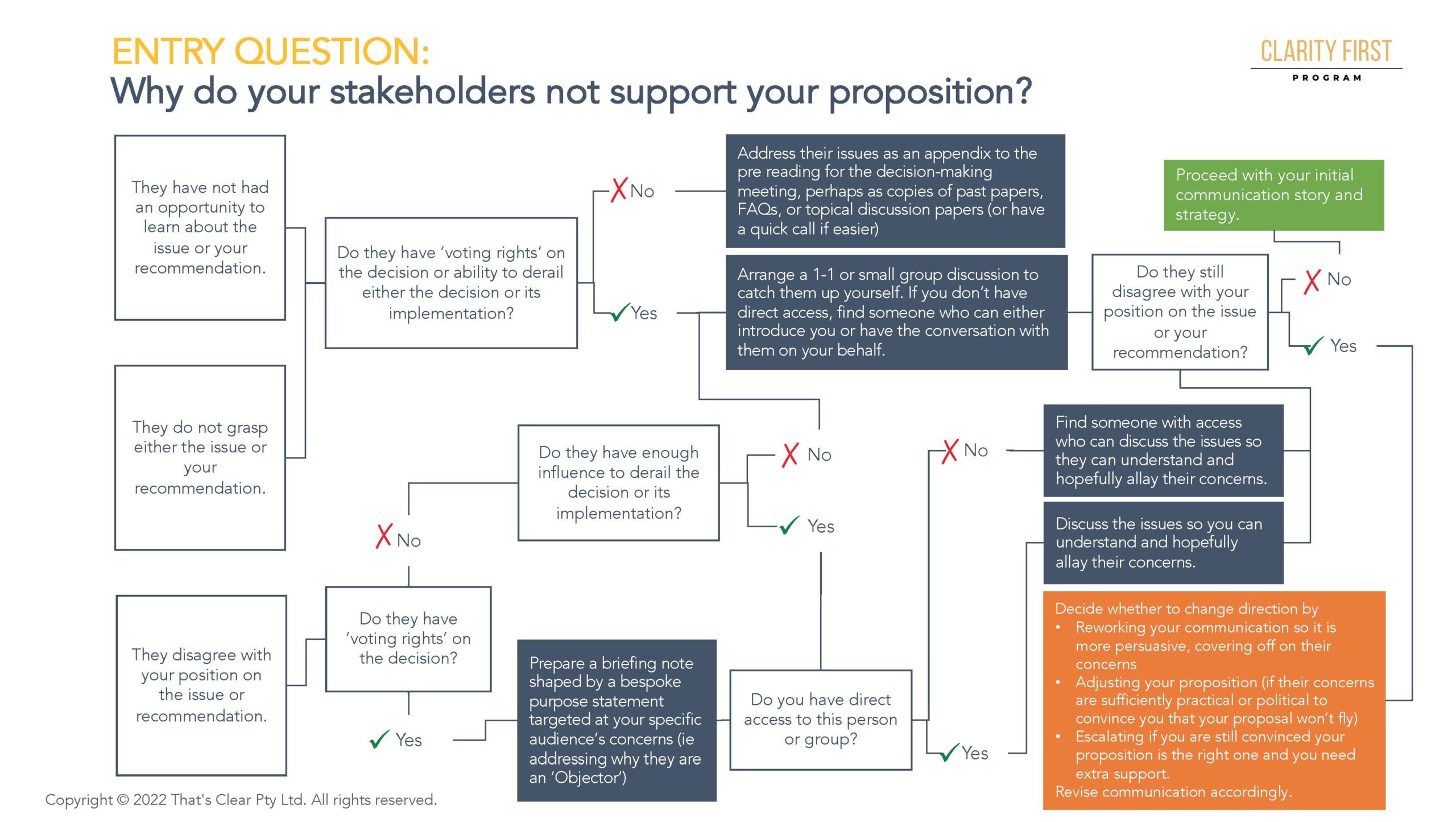
In this particular case, the issue centred around around a common problem, which was how to handle ‘the story' when key stakeholders don't agree with it. Do we ….
Tell the same story regardless?
Edit the story to accommodate that person (or those people) only?
Ask someone else to present on our behalf?
Create a separate story that deals with the objector's specific concerns?
Scrap the story and start again?
There are lots of alternatives, each of which might suit a different situation but none of which suit all.
Hence, the decision tree. I hope you find it useful.
Cheers, Davina
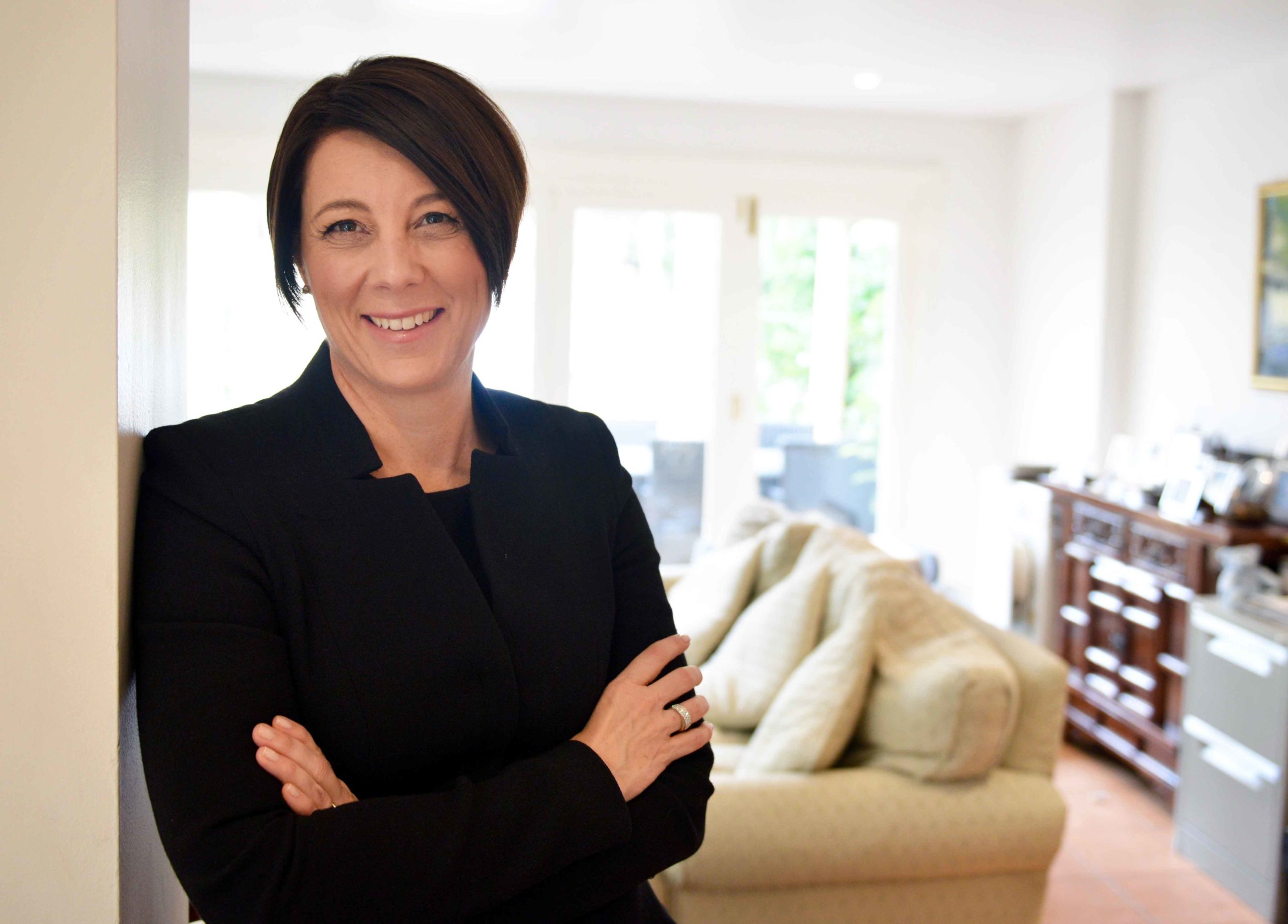
I love what I do.
I help senior leaders and their teams prepare high-quality papers and presentations in a fraction of the time.
This involves 'nailing' the message that will quickly engage decision makers in the required outcome.
I leverage 25+ years' experience including
My approach helps anyone who needs to engage senior leaders and Boards.
Recent clients include 7Eleven, KPMG, Mercer, Meta, Woolworths.
Learn more at www.clarityfirstprogram.com
(*) Numbers are based on 2023 client benchmarking results.
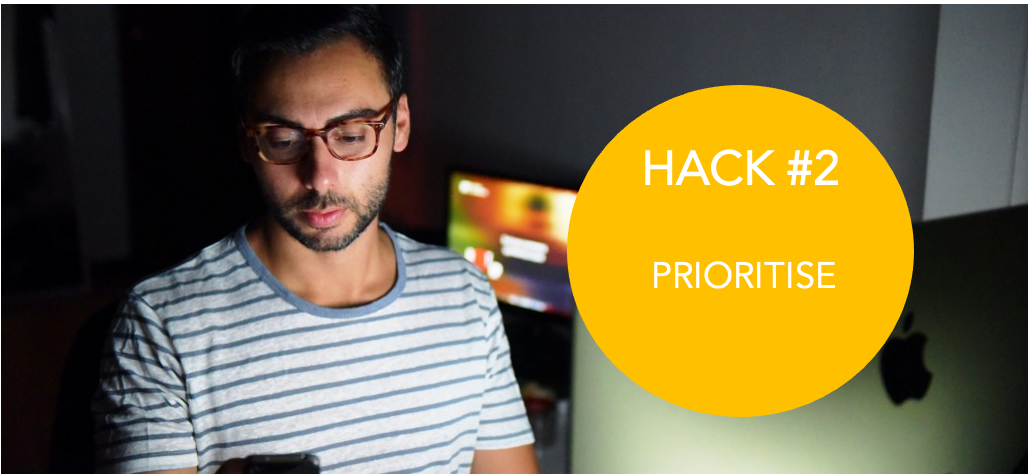
I was stunned at the shift in my perspective after filling in ‘Steve's Strategy Hack' spreadsheet for just a day and how this has continued over the past week.
Click here to read the first post in this series if you have not yet already done so.
So much so that I called him and talked about the first thing I noticed: Most of my time is spent on number ones.
In a way that is good: I am not wasting time. I am mainly working on the things that are both urgent AND important.
At least there are not many number threes or fours that according to the Eisenhower Matrix I mentioned, should be delegated or eliminated.
Interestingly, most of the number threes emerged as I realised I was doing work that others should be doing, and so should definitely be delegated. See my first few days' records here.
Now my challenge is to shift the dynamic and free up time so I can think strategically.
My sense is that by being more focused on the number twos – important but not so urgent tasks – I will be more motivated to fit more number twos into my week.
To achieve that, I turn to Michael Hyatt's Freedom Compass, which I have found to be golden.
The basic premise is that we all need to balance our proficiency and our passion to find and focus on our ‘true north' if we are to add maximum value.
The idea is that we prioritise our time so we spend more time in what Michael calls our Desire Zone. Here are four steps to help achieve this:
Step 1 – Delegate, automate and eliminate anything that belongs in our Drudgery Zone. These are low level repetitive tasks that can be done by someone else or which add less value than we should be delivering in our role.
Since starting this exercise, I have realised these categories fit into two groups: easy things and hard things.
Things that are easy to delegate, which are tasks that someone else in my team is equiped to do both in terms of time available and skills as well as their view of their responsibilities.
In our business, this might include technical problems which I pass to Sheena to solve. She built a lot of our systems and is perfectly positioned to find quick fixes or take the time to investigate more deeply if needed. For the repetitive tasks I ask her to address, she then automates them either with technology or by writing a procedure for our colleague Fatima to process.
Things that are harder to delegate, which are things that involve asking someone else to do something they either do not know how to do or do not want to do.
One of these jumped out at me this week as I was filling in Steve's Strategy Hacking Spreadsheet. In reviewing a draft document a colleague had written, I came unstuck. I reworked it completely when I should not have done so. The author had ‘flicked it to me quickly' and assumed (rightly this time!) that they could effectively delegate upwards and I would fix it.
After reworking it, however, I realised that this was not a good use of my time and I should have instead identified key opportunities for improvement (which I could do within minutes of opening) and asked for them to rework it. This would have been a better learning experience for them and also given me half an hour back as well as reduced my frustration.
Step 2 – Dealing with the things that are in our Disinterest Zone is harder, but just as essential. These are tasks that we may be good at but which frankly bore us. Having a large number of tasks in this zone is a red flag if they can't be automated or passed on to someone else.
This is one area I can get better at. It is just too easy to keep doing admin or other simple tasks which although not value adding are satisfying to the extent that they lead to ‘things being ticked off a list'.
Step 3 – Face up to items that fall in our Distraction Zone. These are items that we like to do, that may be easy for us, but which are beneath us. For example, I make for a very expensive web designer, yet this is one of my hobbies. I love tinkering around and employing some of my design skills on our sites. This is the kind of thing that should not appear too often in my ‘strategy hacker' spreadsheet though, if I am to add real value.
Going through this diagnostic audit has spurred me to action. I just posted a job ad to get someone to help me with some of my marketing activities.
Step 4 – Fire up the things that fall in our Desire Zone. This is where work becomes fun. The more we spend time here, the more value we will add. This is where our passion and proficiency intersect and we can optimise the value we add. The more time we can spend in our Desire Zone the more we will thrive as individuals and as professionals.
For me, this is now about stretching two areas: leadership and marketing. I enjoy getting better at both and can deliver significantly more impact to my business if I excel in both these areas.
Step 5 – Identify what falls into my Development Zone so I can optimise what I can deliver upon, particularly within the Desire Zone. For me this will be a mix of learning how to create more space in my schedule for things that add more value and also how to do the things that might fill that newfound space.
Given my own observations from tracking my activities over the past week, I will focus on getting better at delegating more. The challenge will be to work out what I can delegate to who as well as how to do it successfully.
This will, I hope, give me greater focus as I double down on creating the best possible online learning program and how to market it.
Clarifying this goal is is already building pressure that is motivating me to not imprison myself in a frenetic day of number ones, but rather create fortresses for number twos.
It also makes me realise how essential it is to go beyond the platitudes. The idea of diagnosing, decluttering and prioritising sounds pretty easy.
it done will require some practical tactics such as the ones shared with me by Richard Medcalf of Xquadrant recently. I will share them with you next week too.
In next week's post I will share ideas about ‘fortresses' and ‘prisons' which were just two of the terrific concepts Richard Medcalf of XQuadrant shared with me when we spoke recently.
Keep your eyes peeled for next week's interview.
PS If you enjoyed reading about the Freedom Compass, you might also enjoy Michael Hyatt's excellent book on the topic, Free to Focus. He is one of the people who has inspired me to ‘close the doors on Clarity First' so they are only open three times a year. This will, I think provide both me and my program participants with greater focus as we work to strengthen their communication skills.
Please note, this post contains Amazon affiliate links, and as an Amazon Associate I earn a small amount from qualifying purchases. This helps me cover the costs of delivering my free content to you.

I love what I do.
I help senior leaders and their teams prepare high-quality papers and presentations in a fraction of the time.
This involves 'nailing' the message that will quickly engage decision makers in the required outcome.
I leverage 25+ years' experience including
My approach helps anyone who needs to engage senior leaders and Boards.
Recent clients include 7Eleven, KPMG, Mercer, Meta, Woolworths.
Learn more at www.clarityfirstprogram.com
(*) Numbers are based on 2023 client benchmarking results.
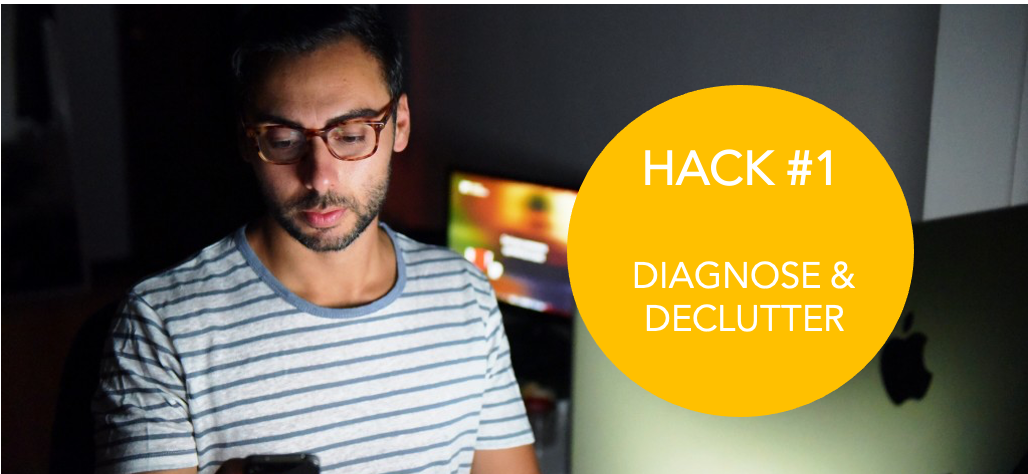
I loved catching up with a Clarity First alum this week for at least two reasons:
#1 – I love hearing how a story we have worked on together lands, and
#2 – I also love it when they can teach me something practical that they have made work for themselves which will also help someone else
Steve rang me to tell me that a major strategy I had helped him develop a couple of years ago has now come to fruition. He got pretty much everything he had aimed for at the start.
We were both delighted.
Given I know him well, I also took advantage of the conversation to ask some questions that I thought he was well placed to answer.
He is not only head of the highly successful Australian arm of a global business, he has a family, works pretty regular hours and ‘knocks off' early on a Wednesday to go sailing.
He has plenty to offer many of my clients, especially a project manager from a technology company, who said this week:
I feel like I am running soooo fast just to deliver – how do I find time to be strategic as well?
So, how did he transition from being an engineer to becoming a strategic leader who takes nights and weekends off as well as going sailing most Wednesday afternoons?
Steve offered some practical hacks for those of us who want to deliver at a more strategic level while not working 24/7.
He said some of the best advice he was given as he moved into leadership was to take control of his time.
So, I have taken his advice and plan to hack my own schedule over the coming weeks to see if I can gain the same sorts of results.
At the moment, getting to yoga on a Wednesday morning would be a sign of success. I have cancelled the last three weeks running.
Let's work out if we can ‘hack our way' to becoming more strategic and get to some fun things outside of work at the same time.
Here is the roadmap for Steve's Hacks. I'll focus one one of these each week for the coming three weeks as I also work to optimise my own schedule and corresponding impact:
Let's get started.
Step 1 – Diagnose and declutter
So, this coming week, I will focus on diagnosing what I am doing now and start to declutter my activities. Here is how Steve suggested I do it:
When interviewing Richard Medcalf of XQuadrant about ideas to help clients become more strategic, he also offered another simple idea. He recommends using a tool called RescueTime to monitor my activity.
It will check how I spend my time when at my computer, eg how much time on email, websites, Word / PowerPoint, etc. It has a 14-day free trial, so I have signed up to see if that gives me some useful information too.
So far as day one goes: it's cool. I am looking forward to shining some light on what tools I am using more and less of.
I'd love to hear how this helps you and will come back not only with Richard's interview but more thoughts over the coming weeks. Feel free to email me and share your experiences.
Talk soon,
Davina
PS If you don't normally receive my emails and want to keep up with the series, subscribe below.
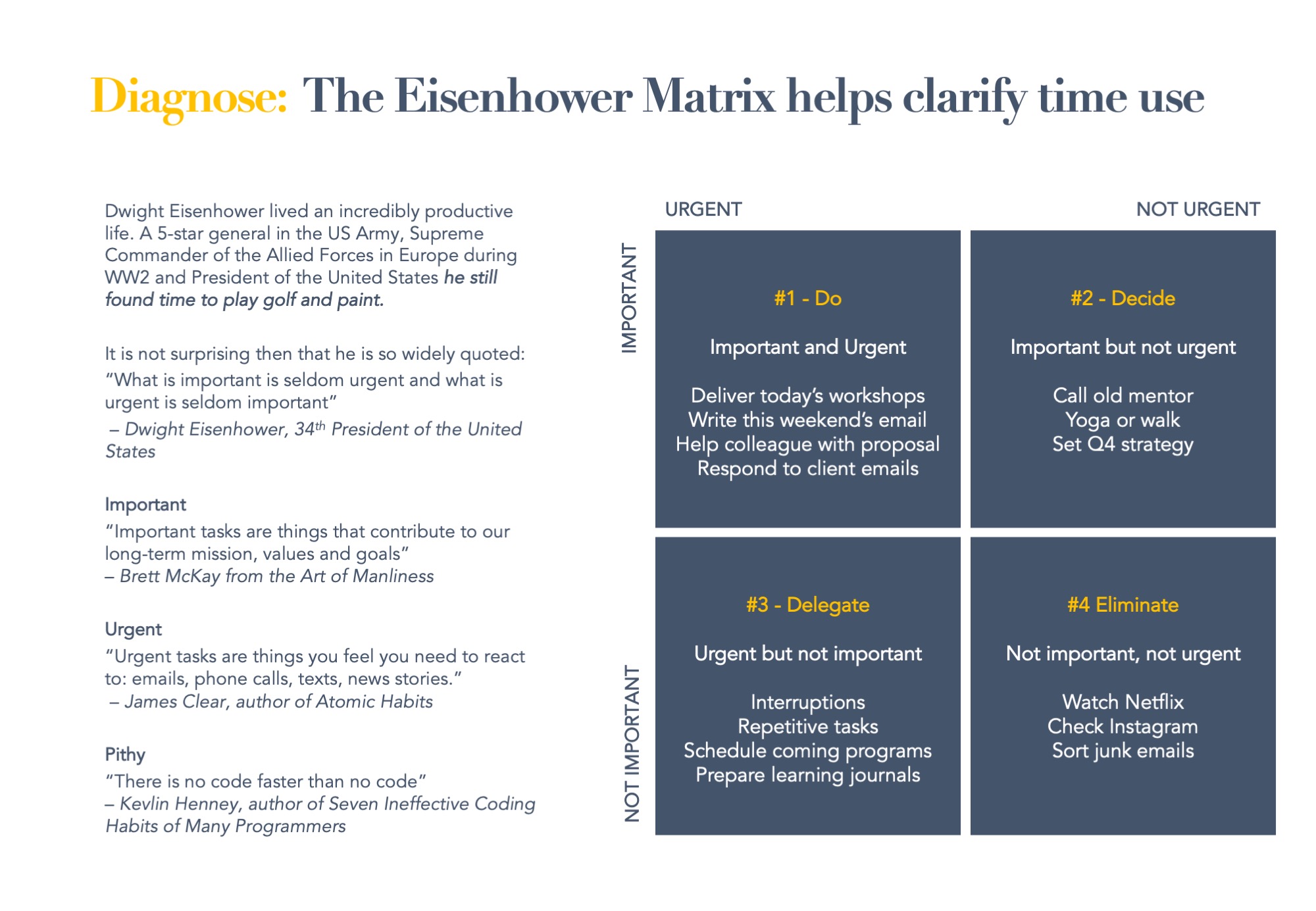

I love what I do.
I help senior leaders and their teams prepare high-quality papers and presentations in a fraction of the time.
This involves 'nailing' the message that will quickly engage decision makers in the required outcome.
I leverage 25+ years' experience including
My approach helps anyone who needs to engage senior leaders and Boards.
Recent clients include 7Eleven, KPMG, Mercer, Meta, Woolworths.
Learn more at www.clarityfirstprogram.com
(*) Numbers are based on 2023 client benchmarking results.
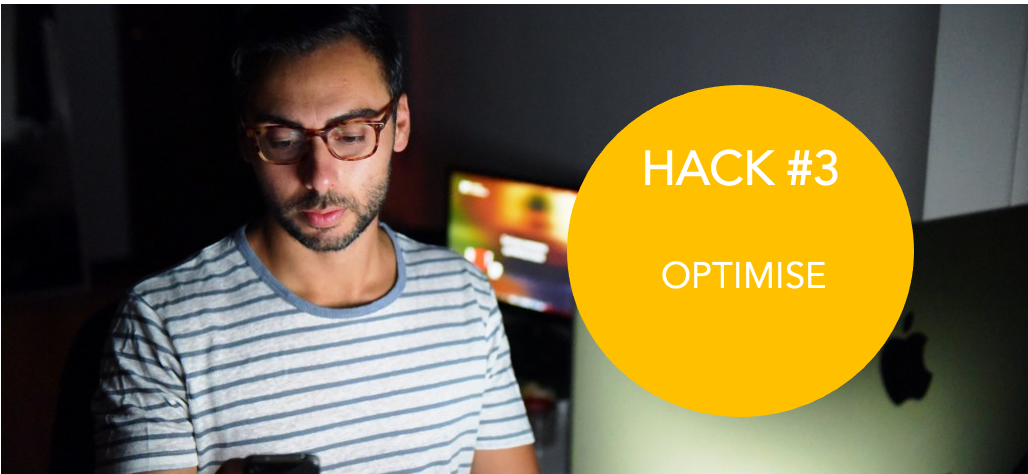
I am usually not a fan of completing audits.
Keeping records of minutiae has never been my strength.
But, wow.
Even though I have by no means kept a perfect record of what I have been up to over the past couple of weeks, the insights have been powerful.
They have certainly helped me get out of the weeds so I can become clearer about ways – to quote today's interview guest – multiply my impact.
Richard Medcalf of Xquadrant specialises in helping successful people do just that.
He offers a number of terrific ideas including how to:
We hope you enjoy this half-hour interview and the free resources he has for you at https://xquadrant.com/clarityfirst/ and check out his new podcast ‘Impact Multiplier CEO' wherever you normally listen to them.
To view a transcript of this discussion, please >> click here >>

I love what I do.
I help senior leaders and their teams prepare high-quality papers and presentations in a fraction of the time.
This involves 'nailing' the message that will quickly engage decision makers in the required outcome.
I leverage 25+ years' experience including
My approach helps anyone who needs to engage senior leaders and Boards.
Recent clients include 7Eleven, KPMG, Mercer, Meta, Woolworths.
Learn more at www.clarityfirstprogram.com
(*) Numbers are based on 2023 client benchmarking results.

I am usually not a fan of completing audits.
Keeping records of minutiae has never been my strength.
But, wow.
Even though I have by no means kept a perfect record of what I have been up to over the past couple of weeks, the insights have been powerful.
They have certainly helped me get out of the weeds so I can become clearer about ways – to quote today's interview guest – multiply my impact.
Richard Medcalf of Xquadrant specialises in helping successful people magnify their impact.
He offers a number of terrific ideas including how to:
And plenty more too.
>> Click here to access the interview as well as some other practical takeaways, including a checklist to help you lead strategically when there is already too much to do.

I love what I do.
I help senior leaders and their teams prepare high-quality papers and presentations in a fraction of the time.
This involves 'nailing' the message that will quickly engage decision makers in the required outcome.
I leverage 25+ years' experience including
My approach helps anyone who needs to engage senior leaders and Boards.
Recent clients include 7Eleven, KPMG, Mercer, Meta, Woolworths.
Learn more at www.clarityfirstprogram.com
(*) Numbers are based on 2023 client benchmarking results.

I was stunned at the shift in my perspective after filling in ‘Steve's Strategy Hack' spreadsheet for just a day and how this has continued over the past week.
Click here to read the first post in this series if you have not yet already done so.
So much so that I called him and talked about the first thing I noticed: Most of my time is spent on number ones.
In a way that is good: I am not wasting time. I am mainly working on the things that are both urgent AND important.
At least there are not many number threes or fours that according to the Eisenhower Matrix I mentioned, should be delegated or eliminated.
Interestingly, most of the number threes emerged as I realised I was doing work that others should be doing, and so should definitely be delegated. See my first few days' records here.
Now my challenge is to shift the dynamic and free up time so I can think strategically.
My sense is that by being more focused on the number twos – important but not so urgent tasks – I will be more motivated to fit more number twos into my week.
To achieve that, I turn to Michael Hyatt's Freedom Compass, which I have found to be golden.
The basic premise is that we all need to balance our proficiency and our passion to find and focus on our ‘true north' if we are to add maximum value.
The idea is that we prioritise our time so we spend more time in what Michael calls our Desire Zone. Here are four steps to help achieve this:
Step 1 – Delegate, automate and eliminate anything that belongs in our Drudgery Zone. These are low level repetitive tasks that can be done by someone else or which add less value than we should be delivering in our role.
Since starting this exercise, I have realised these categories fit into two groups: easy things and hard things.
Things that are easy to delegate, which are tasks that someone else in my team is equiped to do both in terms of time available and skills as well as their view of their responsibilities.
In our business, this might include technical problems which I pass to Sheena to solve. She built a lot of our systems and is perfectly positioned to find quick fixes or take the time to investigate more deeply if needed. For the repetitive tasks I ask her to address, she then automates them either with technology or by writing a procedure for our colleague Fatima to process.
Things that are harder to delegate, which are things that involve asking someone else to do something they either do not know how to do or do not want to do.
One of these jumped out at me this week as I was filling in Steve's Strategy Hacking Spreadsheet. In reviewing a draft document a colleague had written, I came unstuck. I reworked it completely when I should not have done so. The author had ‘flicked it to me quickly' and assumed (rightly this time!) that they could effectively delegate upwards and I would fix it.
After reworking it, however, I realised that this was not a good use of my time and I should have instead identified key opportunities for improvement (which I could do within minutes of opening) and asked for them to rework it. This would have been a better learning experience for them and also given me half an hour back as well as reduced my frustration.
Step 2 – Dealing with the things that are in our Disinterest Zone is harder, but just as essential. These are tasks that we may be good at but which frankly bore us. Having a large number of tasks in this zone is a red flag if they can't be automated or passed on to someone else.
This is one area I can get better at. It is just too easy to keep doing admin or other simple tasks which although not value adding are satisfying to the extent that they lead to ‘things being ticked off a list'.
Step 3 – Face up to items that fall in our Distraction Zone. These are items that we like to do, that may be easy for us, but which are beneath us. For example, I make for a very expensive web designer, yet this is one of my hobbies. I love tinkering around and employing some of my design skills on our sites. This is the kind of thing that should not appear too often in my ‘strategy hacker' spreadsheet though, if I am to add real value.
Going through this diagnostic audit has spurred me to action. I just posted a job ad to get someone to help me with some of my marketing activities.
Step 4 – Fire up the things that fall in our Desire Zone. This is where work becomes fun. The more we spend time here, the more value we will add. This is where our passion and proficiency intersect and we can optimise the value we add. The more time we can spend in our Desire Zone the more we will thrive as individuals and as professionals.
For me, this is now about stretching two areas: leadership and marketing. I enjoy getting better at both and can deliver significantly more impact to my business if I excel in both these areas.
Step 5 – Identify what falls into my Development Zone so I can optimise what I can deliver upon, particularly within the Desire Zone. For me this will be a mix of learning how to create more space in my schedule for things that add more value and also how to do the things that might fill that newfound space.
Given my own observations from tracking my activities over the past week, I will focus on getting better at delegating more. The challenge will be to work out what I can delegate to who as well as how to do it successfully.
This will, I hope, give me greater focus as I double down on creating the best possible online learning program and how to market it.
Clarifying this goal is is already building pressure that is motivating me to not imprison myself in a frenetic day of number ones, but rather create fortresses for number twos.
It also makes me realise how essential it is to go beyond the platitudes. The idea of diagnosing, decluttering and prioritising sounds pretty easy.
it done will require some practical tactics such as the ones shared with me by Richard Medcalf of Xquadrant recently. I will share them with you next week too.
In next week's post I will share ideas about ‘fortresses' and ‘prisons' which were just two of the terrific concepts Richard Medcalf of XQuadrant shared with me when we spoke recently.
Keep your eyes peeled for next week's interview.
PS If you enjoyed reading about the Freedom Compass, you might also enjoy Michael Hyatt's excellent book on the topic, Free to Focus. He is one of the people who has inspired me to ‘close the doors on Clarity First' so they are only open three times a year. This will, I think provide both me and my program participants with greater focus as we work to strengthen their communication skills.
Please note, this post contains Amazon affiliate links, and as an Amazon Associate I earn a small amount from qualifying purchases. This helps me cover the costs of delivering my free content to you.

I love what I do.
I help senior leaders and their teams prepare high-quality papers and presentations in a fraction of the time.
This involves 'nailing' the message that will quickly engage decision makers in the required outcome.
I leverage 25+ years' experience including
My approach helps anyone who needs to engage senior leaders and Boards.
Recent clients include 7Eleven, KPMG, Mercer, Meta, Woolworths.
Learn more at www.clarityfirstprogram.com
(*) Numbers are based on 2023 client benchmarking results.

I loved catching up with a Clarity First alum this week for at least two reasons:
#1 – I love hearing how a story we have worked on together lands, and
#2 – I also love it when they can teach me something practical that they have made work for themselves which will also help someone else
Steve rang me to tell me that a major strategy I had helped him develop a couple of years ago has now come to fruition. He got pretty much everything he had aimed for at the start.
We were both delighted.
Given I know him well, I also took advantage of the conversation to ask some questions that I thought he was well placed to answer.
He is not only head of the highly successful Australian arm of a global business, he has a family, works pretty regular hours and ‘knocks off' early on a Wednesday to go sailing.
He has plenty to offer many of my clients, especially a project manager from a technology company, who said this week:
I feel like I am running soooo fast just to deliver – how do I find time to be strategic as well?
So, how did he transition from being an engineer to becoming a strategic leader who takes nights and weekends off as well as going sailing most Wednesday afternoons?
Steve offered some practical hacks for those of us who want to deliver at a more strategic level while not working 24/7.
He said some of the best advice he was given as he moved into leadership was to take control of his time.
So, I have taken his advice and plan to hack my own schedule over the coming weeks to see if I can gain the same sorts of results.
At the moment, getting to yoga on a Wednesday morning would be a sign of success. I have cancelled the last three weeks running.
Let's work out if we can ‘hack our way' to becoming more strategic and get to some fun things outside of work at the same time.
Here is the roadmap for Steve's Hacks. I'll focus one one of these each week for the coming three weeks as I also work to optimise my own schedule and corresponding impact:
Let's get started.
Step 1 – Diagnose and declutter
So, this coming week, I will focus on diagnosing what I am doing now and start to declutter my activities. Here is how Steve suggested I do it:
When interviewing Richard Medcalf of XQuadrant about ideas to help clients become more strategic, he also offered another simple idea. He recommends using a tool called RescueTime to monitor my activity.
It will check how I spend my time when at my computer, eg how much time on email, websites, Word / PowerPoint, etc. It has a 14-day free trial, so I have signed up to see if that gives me some useful information too.
So far as day one goes: it's cool. I am looking forward to shining some light on what tools I am using more and less of.
I'd love to hear how this helps you and will come back not only with Richard's interview but more thoughts over the coming weeks. Feel free to email me and share your experiences.
Talk soon,
Davina
PS If you don't normally receive my emails and want to keep up with the series, subscribe below.


I love what I do.
I help senior leaders and their teams prepare high-quality papers and presentations in a fraction of the time.
This involves 'nailing' the message that will quickly engage decision makers in the required outcome.
I leverage 25+ years' experience including
My approach helps anyone who needs to engage senior leaders and Boards.
Recent clients include 7Eleven, KPMG, Mercer, Meta, Woolworths.
Learn more at www.clarityfirstprogram.com
(*) Numbers are based on 2023 client benchmarking results.